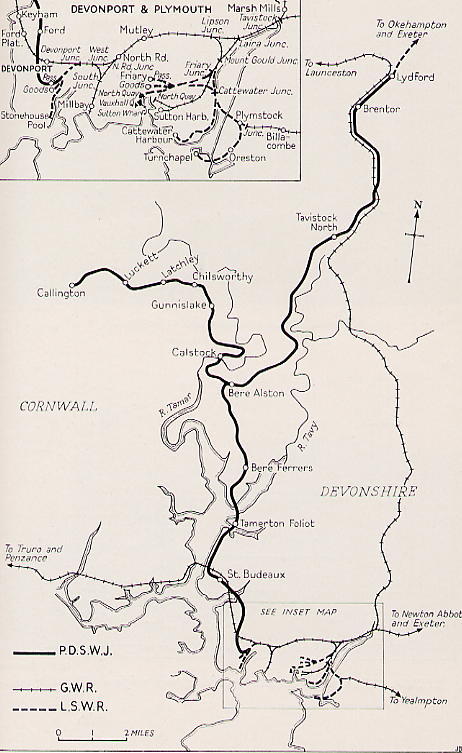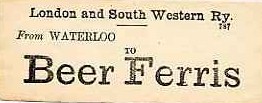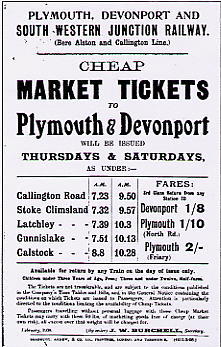| An Outline
History of the Plymouth, Devonport & South Western Junction Railway |
||||||||
|
||||||||
The Plymouth, Devonport & South Western Junction Railway (PD&SWJR) was a nominally-independent railway in the west of the county of Devon, England, which became an important component of the London & South Western Railway's main line to Plymouth.
During the latter half of the 19th Century the London & South Western Railway (L&SWR) expanded their standard-gauge (4'8½") main line westwards from Exeter, around the northern edge of Dartmoor via Okehampton, until it reached Lydford in 1874. By that date Lydford was already served by a station on the single-track broad-gauge (7'0¼) branch of the South Devon Railway (SDR) from Plymouth to Tavistock and Launceston. At the request of the L&SWR the Great Western Railway (GWR), who by then owned the SDR, converted their branch to mixed-gauge. In 1876 the L&SWR made a connection to the GWR branch and then, by using the new standard-gauge track, was able to run their services onwards to Plymouth, where they built a new terminal station at Devonport.
By the end of 1879 the L&SWR had completed the doubling of their line to Lydford. Traffic was growing steadily and the need for two rival companies to share a single-track branch caused increasing problems, particularly as the GWR (being the owning company) of course always gave precedence to their own branch traffic over the main-line traffic of the L&SWR. As a result various schemes were proposed to remedy this situation, such as doubling the GWR branch or building a separate line for the L&SWR.
The Plymouth, Devonport & South Western Junction Railway company was formed in 1883 and its railway was incorporated by an Act of Parliament on 25th August that year. The purpose of the Company was to construct a railway about 22½ miles long from Lydford to Devonport, on a route via Tavistock, Bere Alston and St Budeaux (see map). Work started in March 1887 and the railway finally opened to traffic on 2 June 1890. In addition to the existing L&SWR stations at Lydford (named Lidford until 1897) and Devonport, the PD&SWJR provided new stations at Brentor, Tavistock, Bere Alston, Bere Ferrers (both spelt Beer until 1898), St Budeaux and Ford. Tamerton Foliot station was added in 1897. The line was constructed throughtout as double track. From the outset the new line was leased to, and worked by, the L&SWR although it was never fully controlled by them. The PD&SWJR line gave the L&SWR an independant rail access to Plymouth, so that they no longer had to share the GWR Tavistock branch line. |
 |
|
Map of Plymouth, Devonport & South Western Junction Railway, including main line and Callington branch, and other local lines |
The former L&SWR terminus at Devonport now became a through station and initially L&SWR trains ran as far as the joint GWR/L&SWR station at Plymouth North Road. However in 1891 the L&SWR were able to extend their service to their own terminus at Plymouth Friary, on the east of the city. By a quirk of the geographical history of West Country railways the separate services of the GWR and L&SWR from their respective termini in London now arrived at Plymouth from opposite directions!
The opening of the PD&SWJR enabled the L&SWR to start development of local services in and around Plymouth. In 1906 new halts were opened at Albert Road, Weston Mill and Camels Head in the Plymouth suburbs, serviced by a new fleet of L&SWR railmotors., although subsequently these were replaced by conventional loco-hauled stock. There was considerable local traffic as far as Tavistock.
 |
 |
 In 1891
the PD&SWJR took over the narrow-gauge (3' 6") East
Cornwall Mineral Railway (ECMR) (although the purchase was not completed
until 1894) and in 1908 they extended the ECMR eastwards across the River Tamar to a new
junction at their existing station at Bere Alston. At the same
time the ECMR was re-gauged to the 4' 8½" standard gauge and upgraded to carry
passenger trains, with new stations built to replace the old
mineral depots. The extension was known officially as the "Bere Alston &
Calstock Light Railway", but often it was called simply the "Calstock
Light Railway" and this term seems to have been used for the whole of the line to
Callington.
In 1891
the PD&SWJR took over the narrow-gauge (3' 6") East
Cornwall Mineral Railway (ECMR) (although the purchase was not completed
until 1894) and in 1908 they extended the ECMR eastwards across the River Tamar to a new
junction at their existing station at Bere Alston. At the same
time the ECMR was re-gauged to the 4' 8½" standard gauge and upgraded to carry
passenger trains, with new stations built to replace the old
mineral depots. The extension was known officially as the "Bere Alston &
Calstock Light Railway", but often it was called simply the "Calstock
Light Railway" and this term seems to have been used for the whole of the line to
Callington.
The PD&SWJR inherited from the ECMR two Neilson locomotives and an eclectic mix of goods wagons. For the re-gauged line it purchased some second-hand coaches and a fleet of goods wagons, as well as ordering three new locomotives from Hawthorn Leslie. In general the new locomotives and rolling-stock were confined to the Callington line, as the 'main line' from Lydford to Devonport was worked by L&SWR stock. There are more pages in RailWest about the detailed history of the Callington Branch.
 |
 |
The PD&SWJR retained control of the former ECMR as an independant railway until they were both absorbed by the London & South Western Railway in 1922. At the beginning of the following year (1923) the L&SWR in turn became part of the Southern Railway at the 'Grouping' of most UK railways.
To be continued ...
After nationalisation of the UK railways in 1948 the former PD&SWJR lines were controlled variously by the Southern and Western Regions of British Railways. During the early 1960s freight traffic declined and steam gave way to diesel multiple units (DMUs) for the passenger service on the Callington Branch. There was talk of total closure of that branch, but the poor road access in the area meant that the Calstock Viaduct remained an important link across the Tamar. However on 5-Nov-1966 the branch was closed completely beyond Gunnislake, the rest remaining open for passenger traffic only. On the main line the section from Bere Alston to Lydford (and onwards to Meldon Quarry) was closed completely on 6-May-1968, leaving Bere Alston as the terminus of a branch from Plymouth. The passenger service was revised then, so that trains ran through from Plymouth to Gunnislake with a reversal at Bere Alston. On 7-Sep-1970 Bere Alston signal-box was closed and the line to St Budeaux reduced to a single track serving the former Down platform, which is now the only one in use. Click here for more detailed information about Bere Alston station.
To be continued ...
© Chris Osment 2003
Handbill courtesy of Colonel Stephens Society